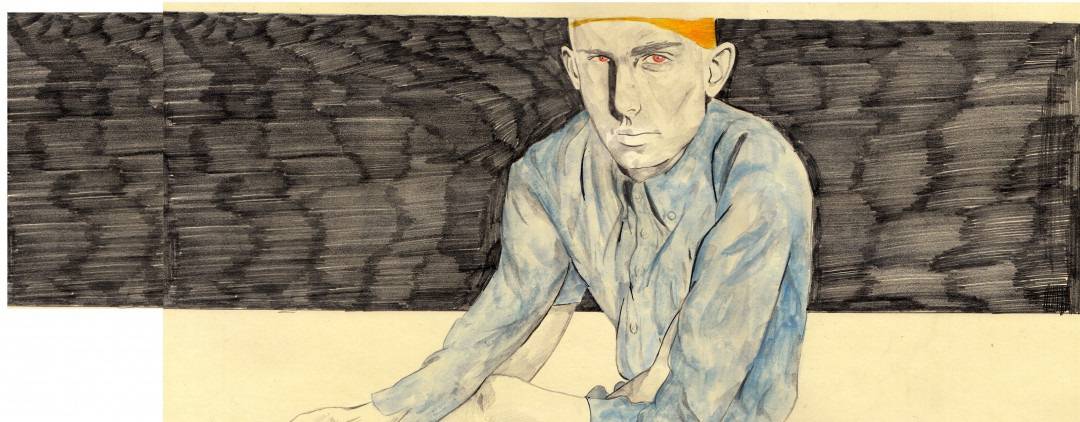
For UK based artist Ryan Humphrey, the internet and all shades of social media are tools for getting his work out there. He’s eager — excited. Ambitious. There’s an inspired fever to his love and willingness to not only explore a wide net of ideas and themes in his work, but also in the ways he finds an audience for his work.
Humphrey’s work is ambitious and immediate. His drawings are rough. You can feel the pencil marks on the paper. The heart takes over, instinctual and raw. A wonderfully manic expulsion of ideas spill on his paper and I can’t stop looking. In his sketchbooks you can see his ideas take shape — the compositions flow with native color, bold contours, and delicate shading. There is a clear voice in his art. Humphrey’s style is enthusiastic and loose. Tender even. An eroticism shines through his drawing with the child-like spirit of exploration.
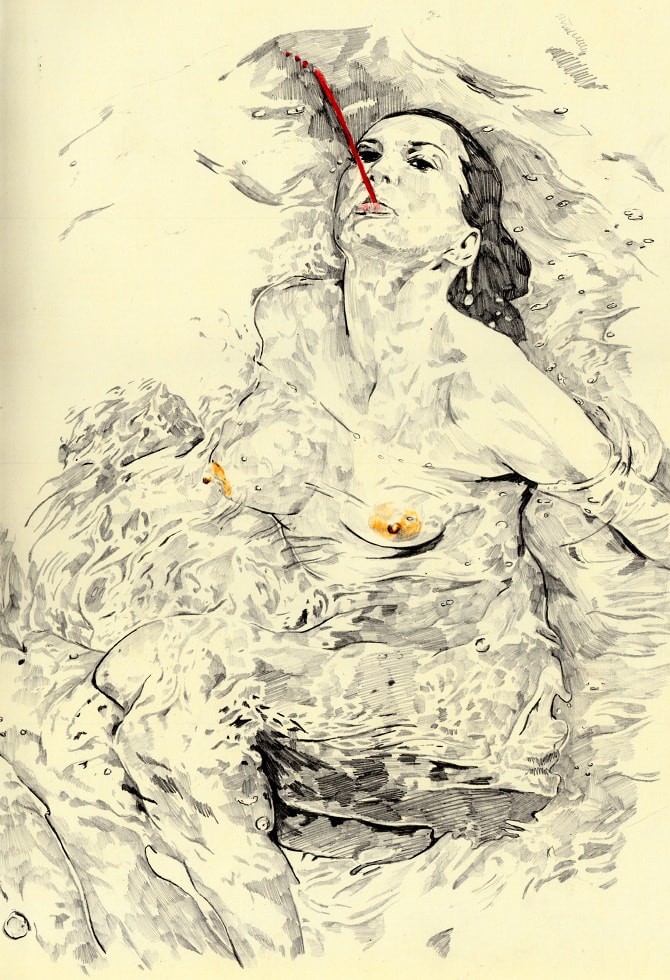
Drawing by Ryan Humphrey
CJ: Your work has a rawness to it – there’s a texture to your work that only handmade art has. Your drawings are from rudimentary tools – a pencil. Colored pencils. Light water colors. With so many digital tools available to the artist these days what makes you stick to the traditional ones? Have you experimented with Illustrator or Photoshop before?
RH: There was a chance to really learn with Photoshop during my time at Art College but that experience was so awful I nearly put my fist through the screen. I think for me, making work has been based around patience and using Photoshop was very time-consuming. The natural feel of being traditional – using pencils and paint – has been with me my whole life. There isn’t a feeling quite like making your own colours, sharpening your own pencil lead to a point you feel comfortable with.
It took me a good couple of months to understand what lead shape and shade best suited me, and that was all from learning basic ways. It seems too easy to download and have that vast amount of brush types on your computer.
I’ve always deep down wanted to try and learn more of Photoshop now, and I mainly use it to clean up bits of dirt and to copy and paste drawings together, but I know in my heart that traditional way of working won’t leave. Plus the feedback I’ve received about sticking to old ways which is refreshing for the audience makes me happy too.
There’s a wonderful spontaneity to your drawings, a free-flowing exploration of form. How much planning is there to your work? When looking at something like your version of ‘Battle Royale’ with the characters from ‘The Simpsons’ it would seem that some type of sketch work would need to be done beforehand, yet you keep the work so loose and alive. What’s your process on a project like that?
It’s strange because most of the work I do there is hardly any planning at all. Some of the ideas that pop in my head appear instantly and then I start to work right away. I work usually in one good hit; nearly all of my work will be completed in around 3 days. I try to make them as fresh as the idea is in my head.
In some occasions I do the most unbelievable rough doodles for plans for bigger drawings, that really only I can actually know what they mean.
For the ‘Bartle Royale‘ project, it was totally different. I knew an idea like that would need some careful planning and for it to go all right. What I did for that was to research all of the students at Springfield elementary, all the different years and decide who was going to live and more importantly, how was each of these characters going to die.
I made a small list of the order of each death, just like the film. With projects like this, it makes me feel more careful and more of an adult, with this level of thinking for this kind of project as most of the other drawings and ideas are more fun and instant.
There is a wonderful child-like energy to your work — it’s loose and rough, yet incredibly direct. It’s interesting that you feel that projects like ‘Bartle Royale’, projects that take some care, make you feel more of an adult. I totally get that. Once you start working on projects that are more than just doodles or sketches, projects that require a narrative flow — it demands you to take control and pay close attention to the details going on.
Is there a danger to losing something, maybe something small, in this growth? Do you feel your style, or voice, slowly changing?
I felt a tiny bit that I lost control with ‘Bartkira’ being a wide project, because all of the popularity and coverage it got. All of the work I create there is a feeling that its all mine and I have total control of it, but as soon as it’s online you tend to lose that ownership. That’s why for ‘Bartle Royale’, I am going to do all the work and give it the best I can.
Sometimes the small changes do get lost in all the big pieces I do, even now I can look at old work and think, ‘yeah this can be much better now’ or ‘I’ve missed something here.’ I have all my work saved from the last 5 years on my laptop, and from time to time I still look at it and see the change.
It’s great to keep old work because you could easily delete all your past things with disgust because you feel ashamed to look at it. You see the mistakes and don’t want to be reminded of them, but for me I adore mistakes because they improve you. Whenever a line or a tone has gone wrong even now I keep it and work with it.
Being younger I would constantly erase pieces and that irritated me so my way of working now is never to use an erasure so you have that carefulness when working. Mistakes aren’t all bad. I do wonder how I will change things in the future, but that usually happens when I start to draw different subjects like a car, or landscape.
Your illustrations for the ‘Bartkira’ project are poetic in execution – so loose and clean. They quickly get to the heart of the moment you’re depicting. Do you have a different approach to a more directly narrative project like that than to your other work?
‘Bartkira’ was more different because that was at first just for fun, for me to create. Nearly all what I do is for my own enjoyment and sometimes you get lucky and other people love it as well. With that looseness it was more with still about the movement of the image.
What I noticed and adore especially with Otomo’s ‘Akira’ is that nearly every panel has movement in them and you can visually engage with each page. The level of detail as well was a factor to keep with my ‘Bartkira’ because I wanted to maintain some sort of detail like ‘Akira’, but have that simplicity that you get from The Simpsons, especially older seasons. You could draw any Simpson character in any way, yet it will still have that same quality of being a Simpson.
That’s so true. Even with some of the looseness in your drawings, you never lose the recognizable Simpson quality to the characters.
How did you get involved in the ‘Bartkira’ project?
I guess I should mention how ‘Bartkira’ pretty much started.
I saw a Tumblr blog alled thesimpsonsdrawingclub.tumblr.com and I thought to myself ‘this is so cool I really want to be a part of this!’ so instantly I started to figure out what I could do that was Simpson related.
The first idea was going to be a comic based on Ralph befriending a dead body he has found and he believes this body can talk to him. As time went on this idea was starting to be a struggle so just by chance I saw all my ‘Akira’ novels and thought ‘oh this could work,’ so then I was flicking through the pages and saw when ‘Akira’ is awakened and swapped him for Bart. This kind of mash-up was heavily based around the old Treehouse of Horrors from The Simpsons as they are my favourite episodes (My favourite being The Homega Man).
Once I uploaded the small comic on my Tumblr it was a viral hit and I received an email from an illustrator called James Harvey, who said to me that this comic deserves to be serious and be made bigger. He told me of this project and how loads of people could redo the whole thing with The Simpsons and I agreed to it all, because deep down a project like this could of got some nice exposure and to have lots of cool artists and people on board would be a nice feeling. The announcement was made and the rest is history, haha!
What’s it like to collaborate with other artists? How does that work? Where does your voice, your style, come in?
That feeling when you are working with someone is one of the best, because being an artist you tend to work on your own, doing your own thing. Sharing ideas with another is a great feeling because every artist is different, so whenever I get the chance to I jump on it. It mainly works through meet ups or emails, just talking about what ideas we both have and putting them together.
It’s especially more interesting now working with others from another country, so for that, we usually post each other drawings to work on, scan them up and send them back. Seeing a different mark on paper is one of the things I really like. One of the most enjoyable collaborations I did was doing work based around killers (see above ‘Ed Gein’ piece) that ended up looking like fashion sets, so collaboration work can have plenty of plus sides.
With your projects like ‘Bartle Royale’, is there a plan to make a physical book with your narrative pieces?
Oh yes, that is the final outcome for ‘Bartle Royale’ to have that made into a small book. I have made smaller zines and filled up sketchbooks with just one theme, but to have an actual book made would be the perfect fitting. I did some rough numbers and thought that ‘Bartle Royale’ will be around 300-500 pages long so the idea of making it into volumes might be another option. It’s hard to think what can work and be much easier for a project like this but lucky enough this is a project that will have time taken on it.
You’ve spent some time in art school. We have that in common. I did summer programs and then entered a fine arts program. What was your experience like? Do you think it helped you evolve? Was your work accepted there?
I think you can relate to how pretty cool art colleges are definitely some of the best places to be a part of. I’ve always enjoyed my time throughout university, being around other people that love what they make. It’s kind of like what I said before, about artists being their own person. You are around different people but all doing the same thing and making work.
The final year was my most positive experience on my MA Illustration course, purely because it felt like I found my true voice in making images. Before that doing a Fine Art degree I was left with far more questions than answers but doing illustration the questions that faced me were finally answered about who I was as a person. The evolving was very evident, especially with my drawing ability, but that was more to do I feel with taking a gap year before doing my masters, to focus on drawing.
Your celebrity portraits (Nic Cage, Kurt Russell, etc.) are both funny and sophisticated. A lot of artists attempt to do known characters and it can easily become cheap, done for irony’s sake, but yours stand out as brilliant pieces of art. Do you consider that balance when drawing something like ‘Bartkira’ or your John Carpenter series? How do you keep your work grounded?
That was always a factor when drawing celebrities, was to draw characters that were more from cult films than the well-known ones. The celebrities I have drawn are all from my most favourite films, so to already approach drawing characters you like made things much easier. What was an importance was that each film portrait had small elements of them from the films, so to include small features, like Leon’s house plant, the small tattoos on Roy Batty from ‘Blade Runner.’
I notice a lot on my website that there is a selection of different styles of drawing and that is what I feel makes it more interesting. When you can draw detail well enough so that the drawing itself is obvious of the portrait then to go simplistic and loose like the ‘Bartle Royale’ drawings is strong. The main thing for me is that I love drawing and making an image in any way that is best suited to what it is.
I found your work on Society6, and before that I would look for new artists on Tumblr or wherever else I could find it. What outlets have you been using to get your work out there? What’s been the best, in terms of you getting the most eyeballs on your work?
I think more than ever Society6 is a great place to show work online, because the amount of Tumblr artists that use it now is getting bigger. Plus you have that added part of people buying your prints and shirts too. The other main outlets I use are Twitter and Flickr, but deep down it’s always been the use of Tumblr that has helped me gain more viral attention.
The power of blogging now, especially for young artists to show work can only get better, plus it’s helped the likes of Hayley Williams from Paramore re-blog some of my work, as well as Liam Payne from One Direction. He did follow me for a bit but soon unfollowed and I have no regrets.
You sell your work through Society6, but have you thought of having your own store to do things like limited run prints or posters? As someone who is a bit of a collector, I personally dig buying limited run prints or whatever directly from the artist, and you seem to enjoy being involved with your fan base, so I was curious if we’ll be seeing some of your art blown up as a screenprint or something like that?
That idea has popped in my mind numerous times, and to have work done that’s been screen printed would be wicked! I have a shop that I do use to sell zines on and badges from time to time, but it was more of an experiment.
I’ve never really been into doing screen prints, I had a small go during my time in Uni but it never really felt ‘me’ but I guess now is a good time to try. I am starting to do more loose watercolours that I will think about selling on a personal shop that could be a good idea. You have inspired me to do so haha!
You should! I’d love to see you’d come up with.
Beyond your incredible work, you also have an infectious enthusiasm for getting your work seen and participating in projects — you appear to love exploring where your art can go and take you. Who do you consider your audience to be?
Oh man, sometimes I wonder who actually looks at my work! I don’t know who it could be but deep down I think that’s great to not know. What I like about the use of Tumblr is that ANYONE can have a blog and see what you are doing. I know I have a bit of a diverse audience already, from cam girls to fashion models that follow me and that makes me feel cool.
I tend to work for more of a younger adult audience because most of the work can be ‘internet humour’ related from memes to the cult film characters we were talking about. I was tutoring for a few months to 16 year-olds and some of them knew my film characters I illustrated so that was much easier to explain who they were. To me, I like to try and do work for all people and any age, just as long as I enjoy it then other people can too.
Your drawings exist in an interesting space – they’d be equally at home in a magazine as they would be in a gallery. Where do you see your work going? Is there an arena or genre you’d like to explore next?
When I was younger, it was always about having exhibitions and being involved with them. As time went on and the lure of other formats to show work was more interesting, as in the past I never would of thought a piece of my work would go well as a t-shirt design. I think all areas would interest me, just as long as my work was out there getting some exposure.
The art world is a big one, so you need to show yourself as much as you can. An area that has always been my personal interest is book illustrations, for covers, even magazine illustrations. I mainly work from a vast amount of second-hand imagery; the drawings themselves look like something from a fashion set so I’d like to try that out somehow. I don’t know deep down where my work will go next, but I am totally enjoying the never knowing ride and if I can still love drawing then I’m in for a right result.

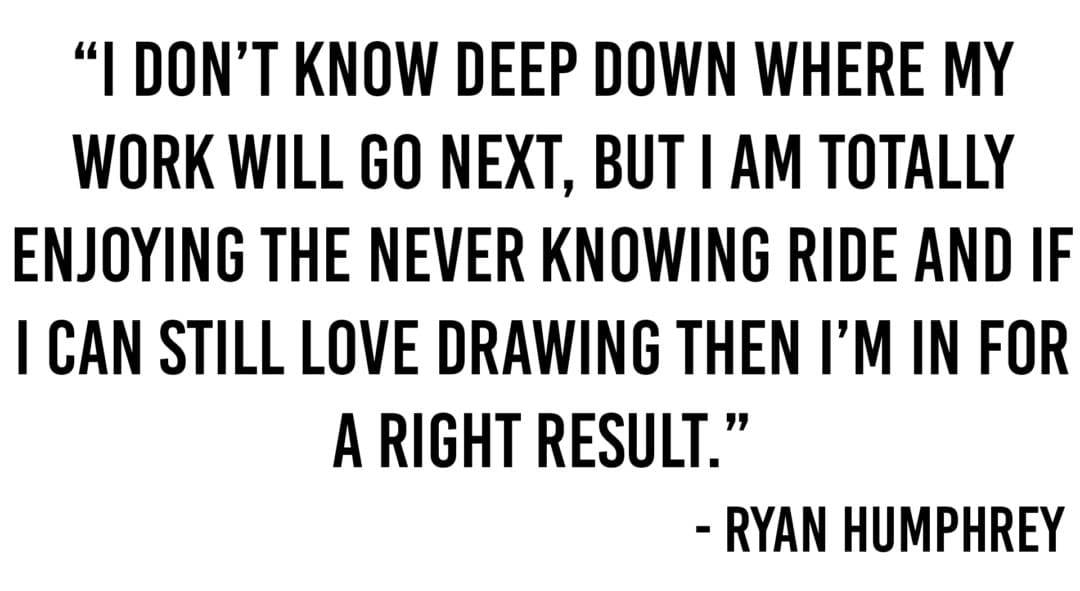
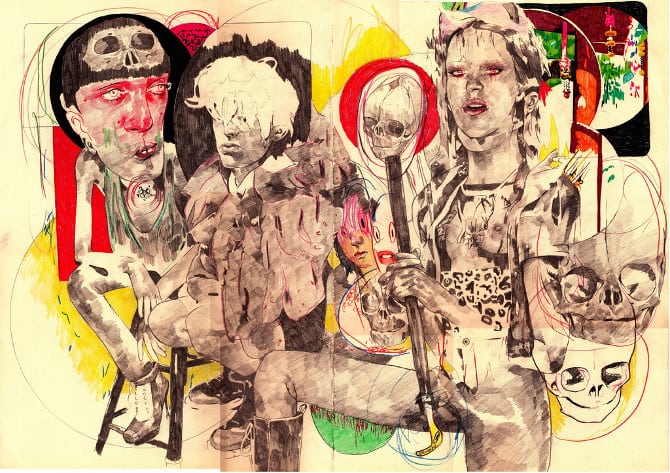
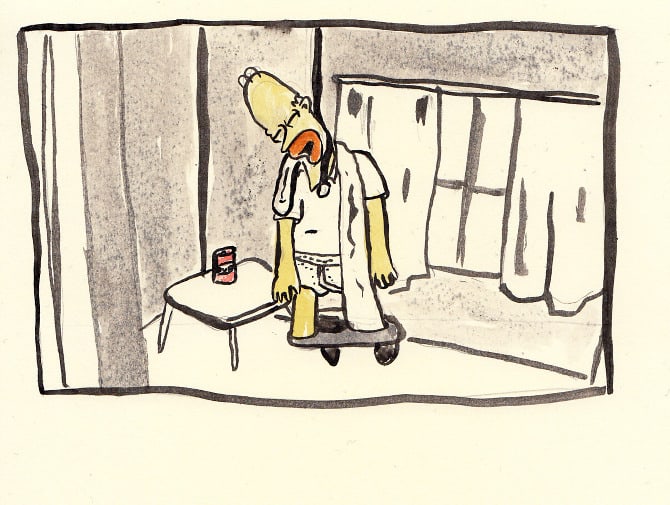
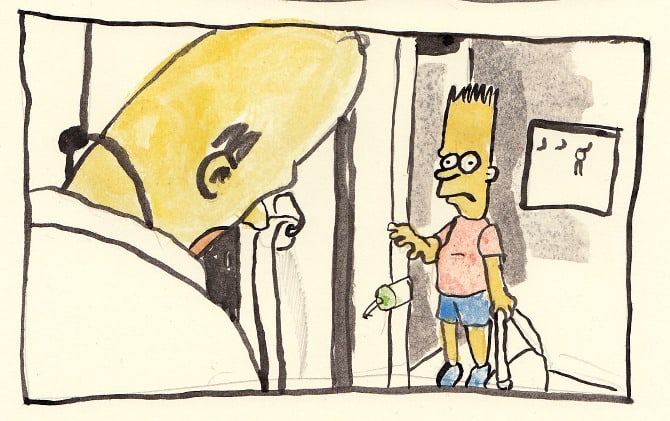
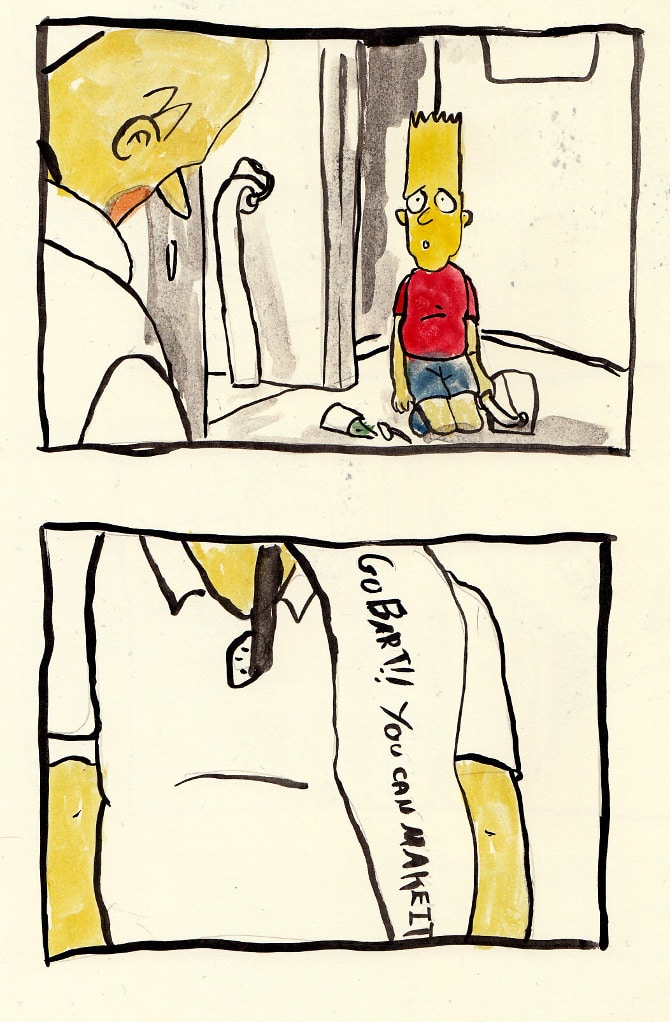
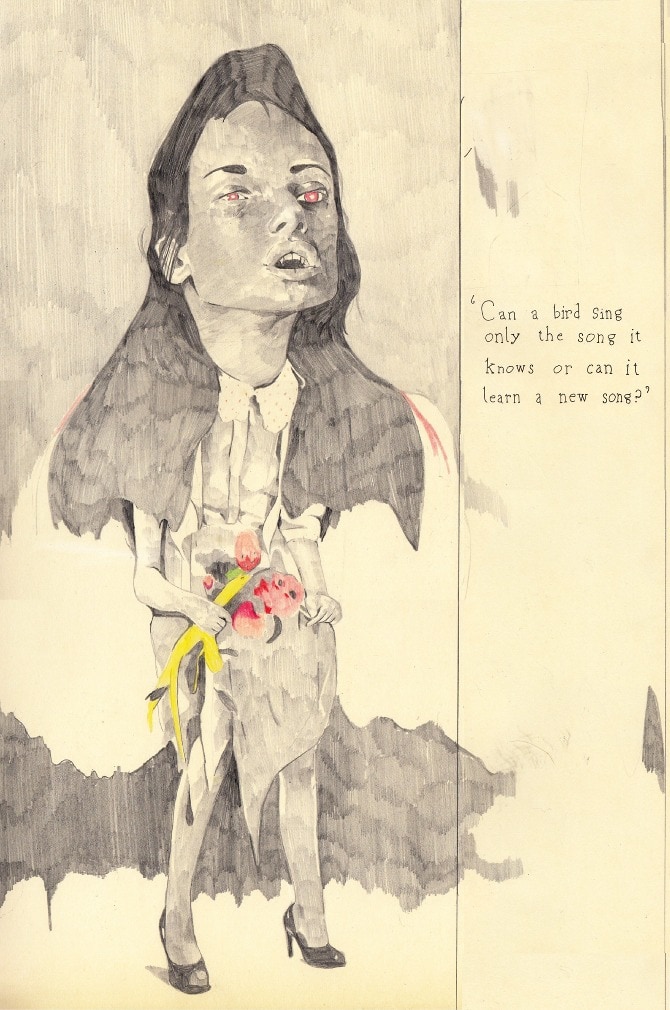
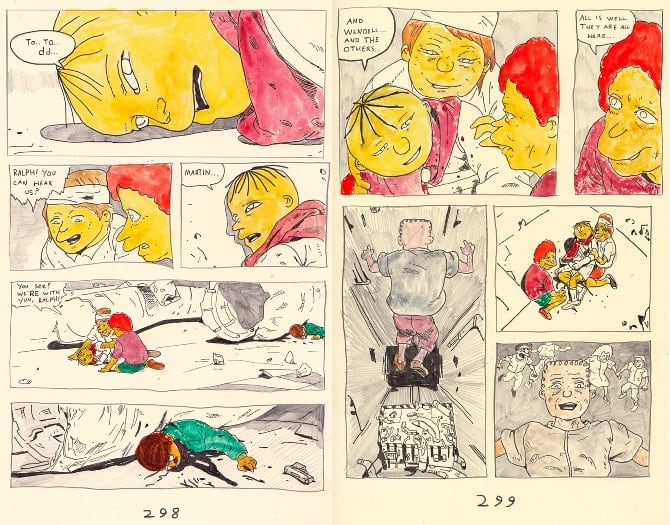
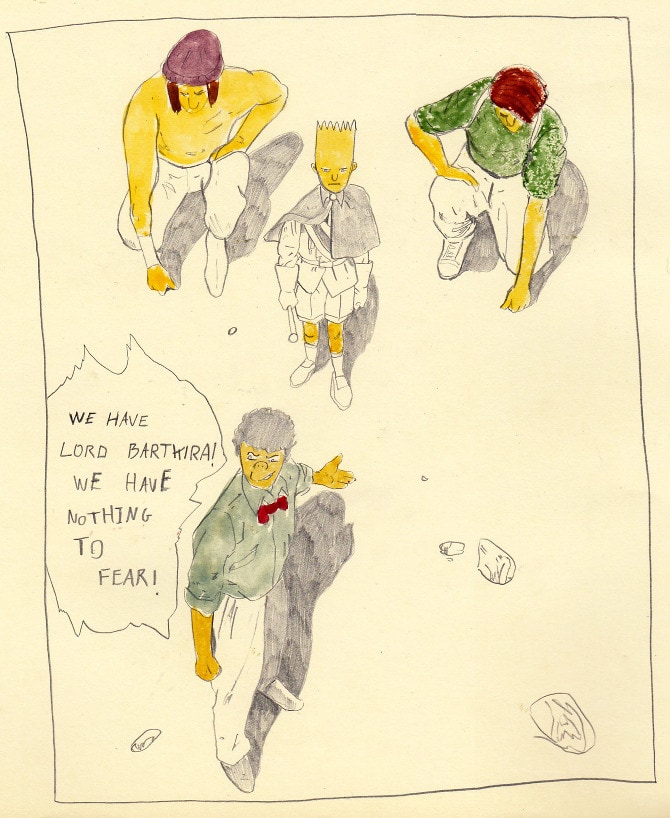
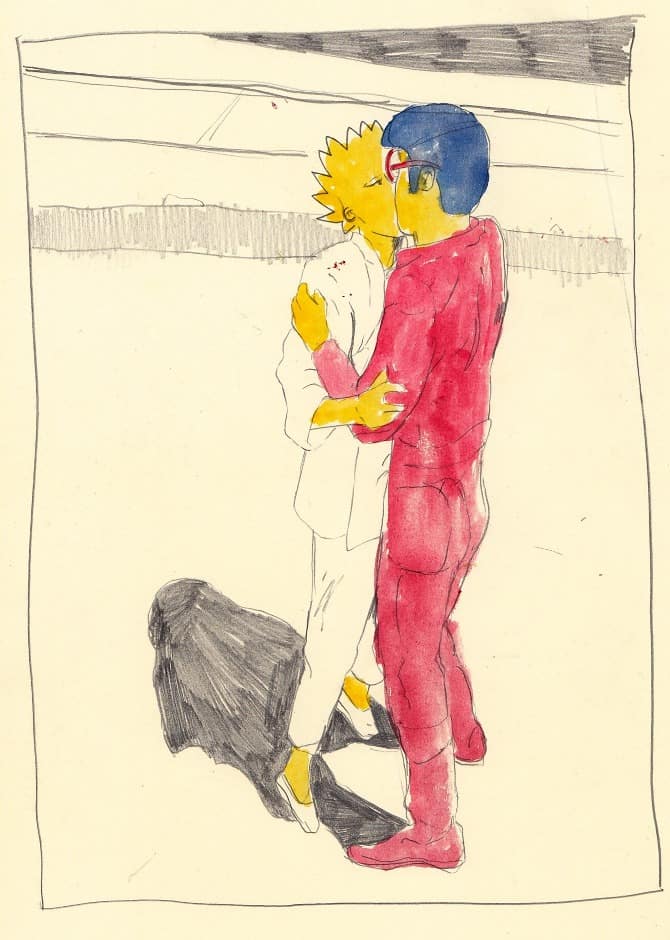
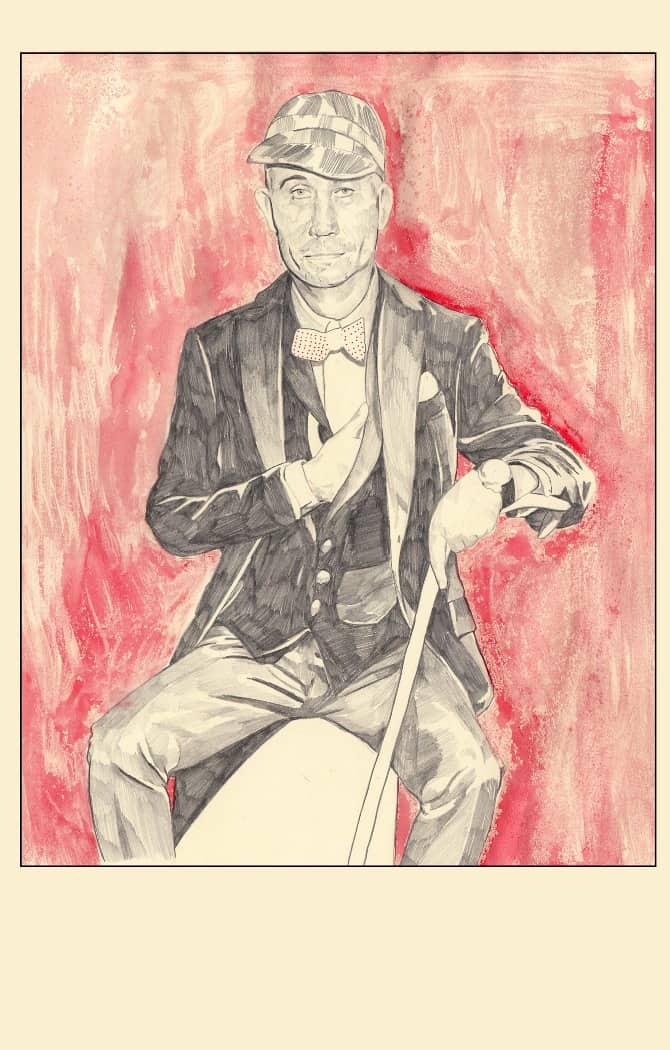
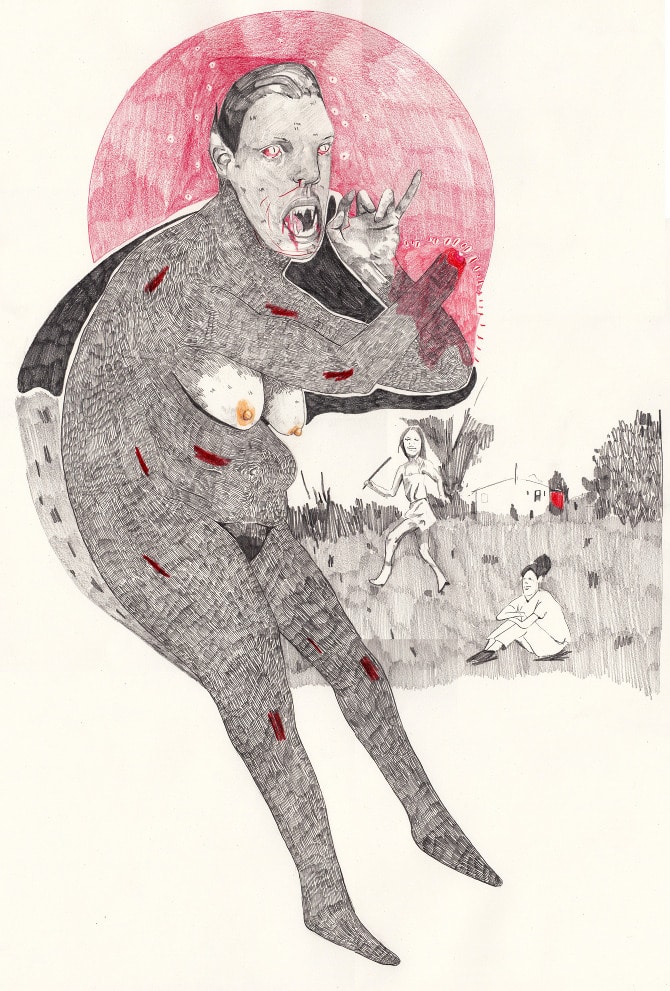
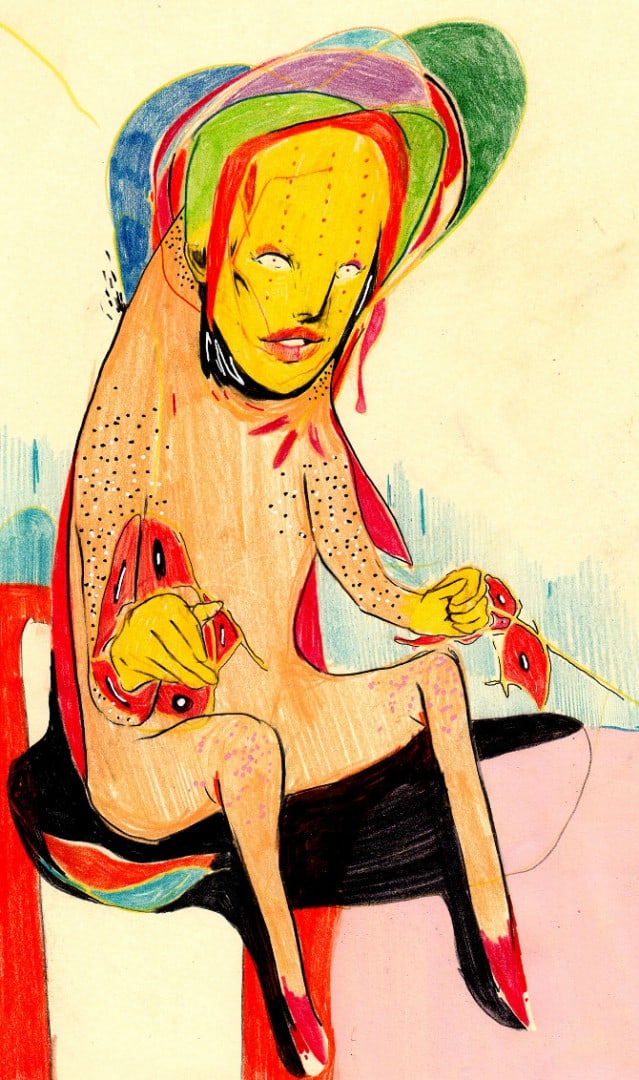
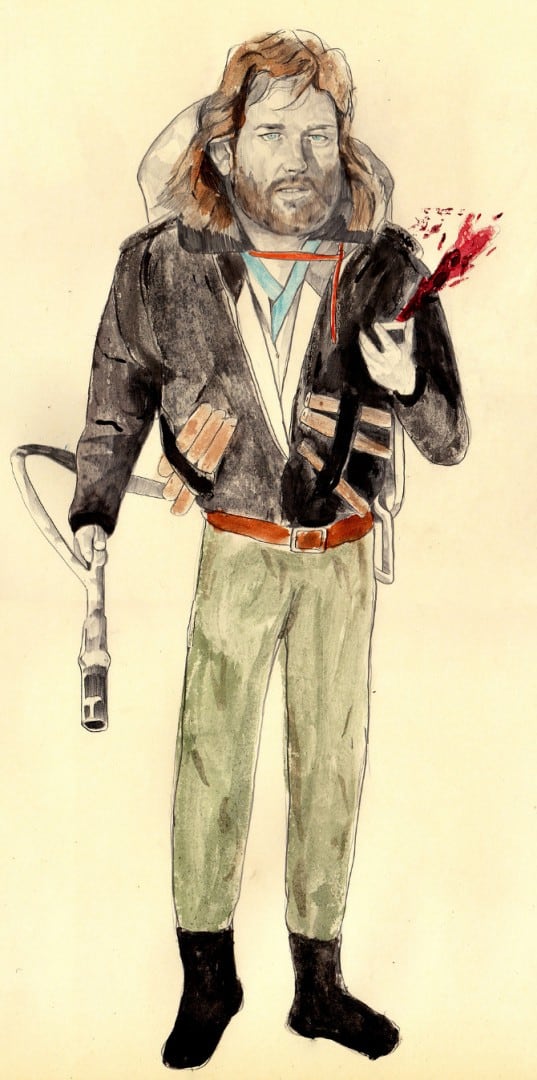
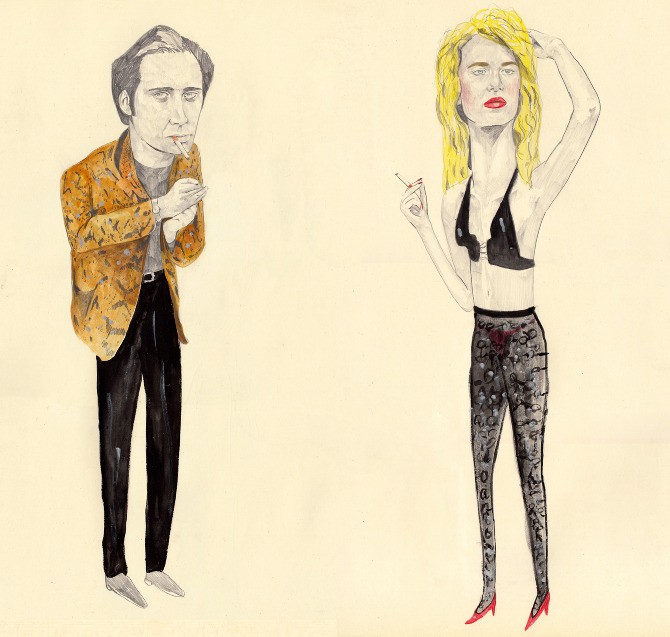
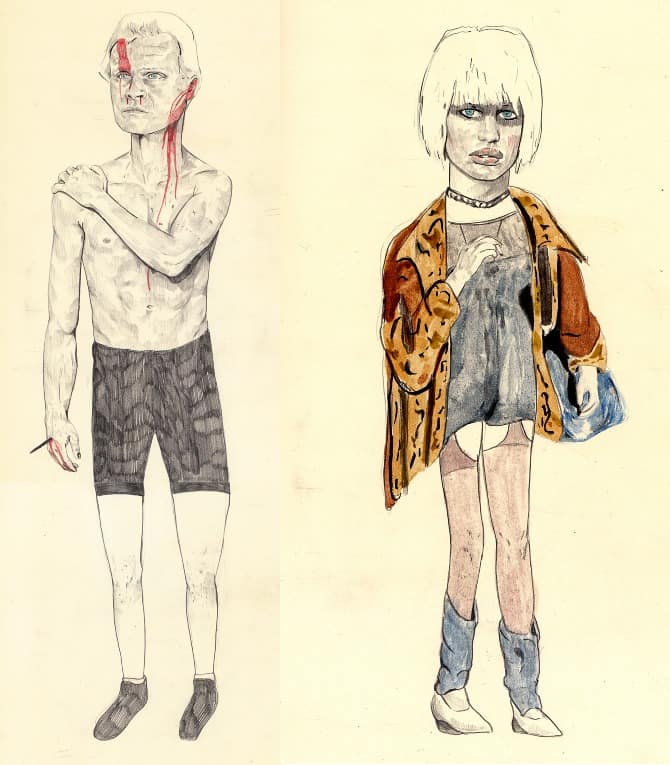
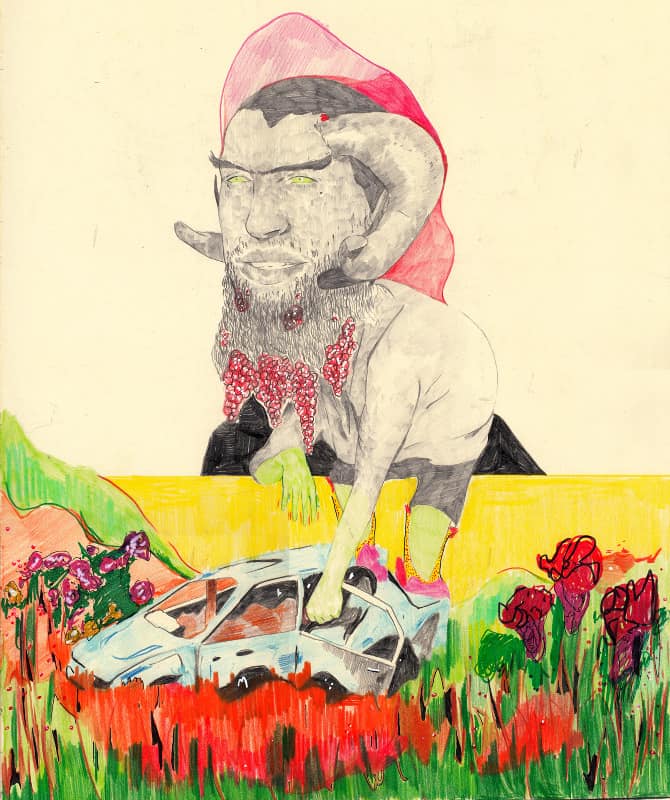

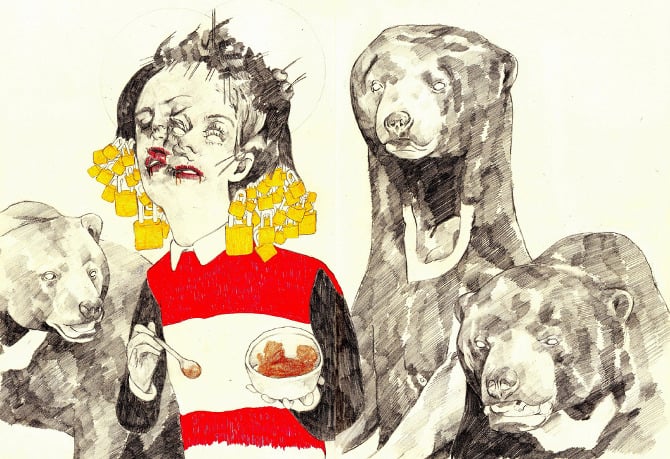
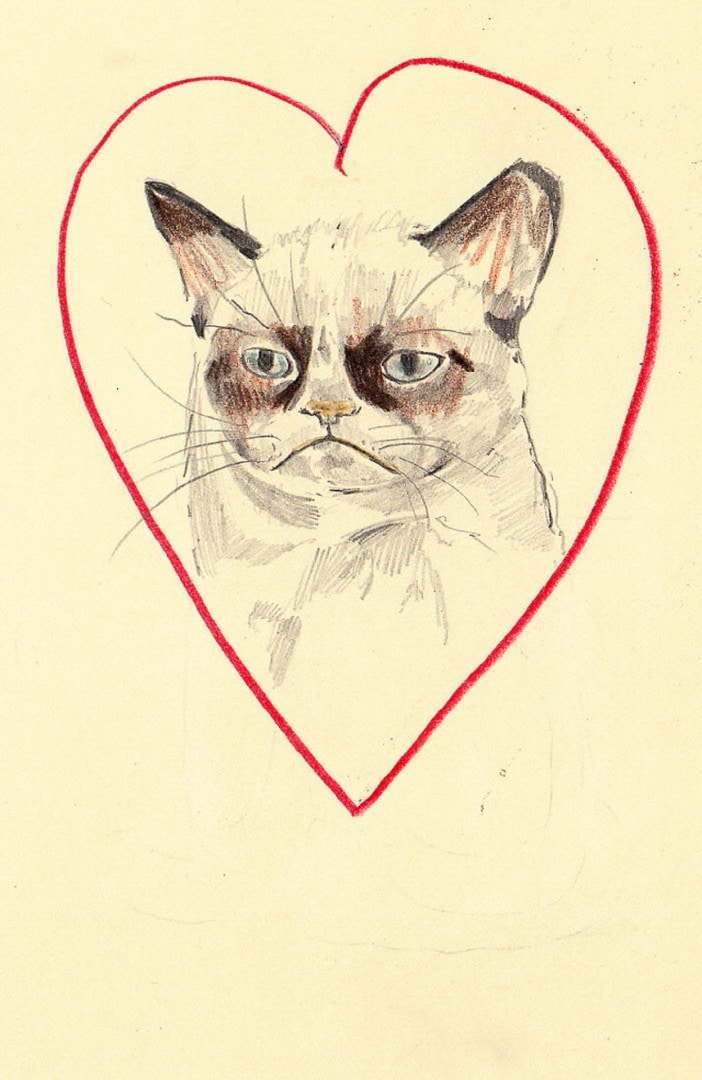
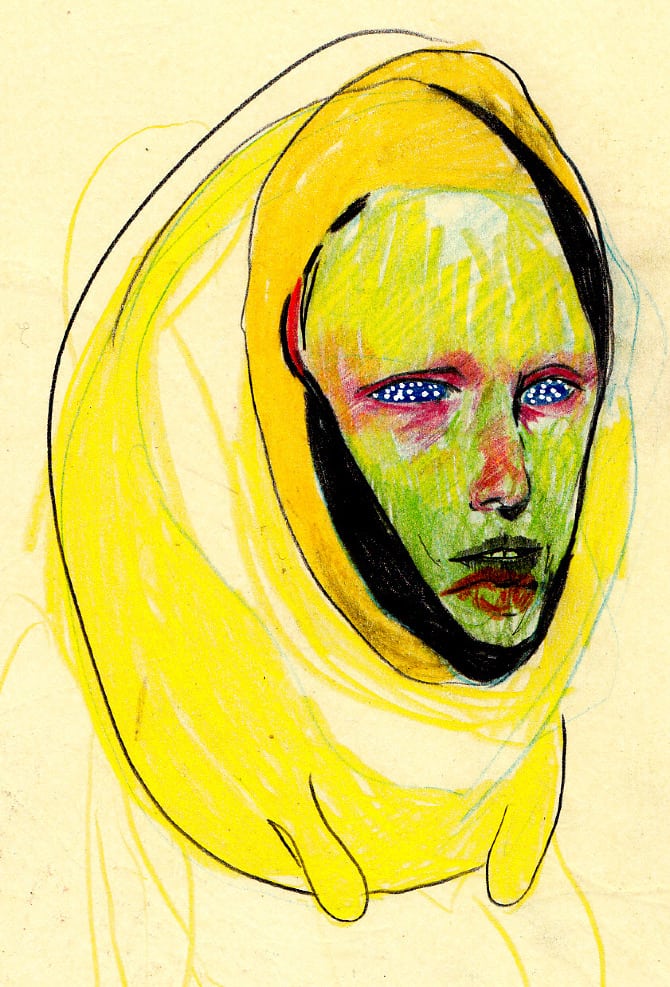
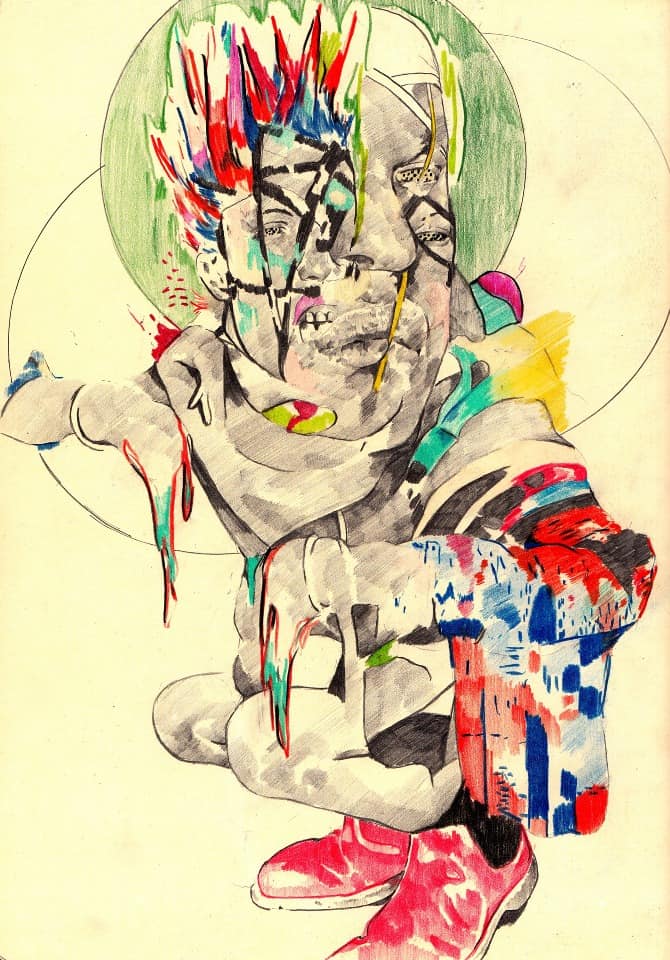

strange art…but seems to be talent in the making. some are just awesome… more detail…. nice… thinkative..
retropect… respect.. no rejects.. need picture art that we can put on our walls in the “living” room.
maybe too many drugs floating within the aspects of the art…. artificial mental art… be more realistic and your art will take off.
thanks for the fantastic art tho…
Love the… ‘can a bird learn a new song….” one!!